The BRAWL² Tournament Challenge has been announced!
It starts May 12, and ends Oct 17. Let's see what you got!
https://polycount.com/discussion/237047/the-brawl²-tournament
It starts May 12, and ends Oct 17. Let's see what you got!
https://polycount.com/discussion/237047/the-brawl²-tournament
Lys 1.0.1 Released!

Hi everyone!
After a long public beta we have finally arrived and the wait is over! Lys 1.0 has been released!
We would like to truly thank everyone for all their hard work & dedication in helping us make Lys the best that it can be.
Going forward our journey will continue to update and improve Lys, so please feel free to keep offering us your suggestions & giving us your valuable feedback. We couldnt have done this without you!
You can now view pricing & purchase Lys HERE
The Lys Open Beta will be deactivated on March 1st but for those who wish to continue evaluation, we also have a demo version that is available for people to test system compatibility and other such workflow considerations.
Thanks again for all the support everyone!
Enjoy!
Kind regards,
The KnaldTech team.
What is Lys?
Lys is an ultra-fast GPU powered solution that sets the standard for generating Radiance, Irradiance and Specular textures from panoramic, Sphere or 2d cube map cross source textures for use with HDR Image Based Lighting.
With the ability to convert, manipulate and tweak your source images in real-time, generate Radiance, Irradiance and Specular textures on the fly and choose between Cosine weighted, GGX and Gaussian specular terms with fully automated BRDF convolved MIP maps with user configurable varying Specular Power or Roughness, Lys can help give you the tools and functionality that you need to ensure that your projects HDR Image based lighting pipeline is the best that it can be.
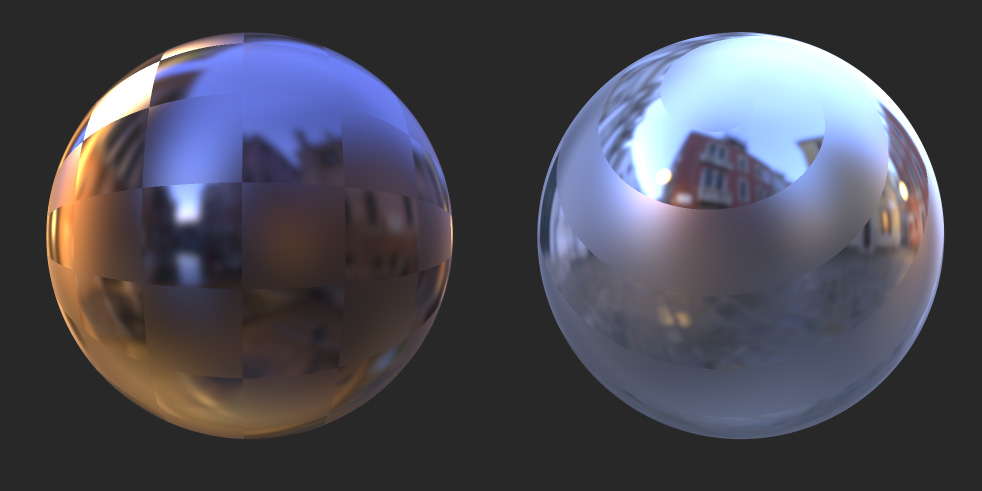
Real-time cross conversion between panoramic, Sphere and cube maps
Converting between panoramic (longitude/latitude), sphere (image probes) and cube maps while preserving original image quality is a breeze. Simply import any of the aforementioned images and Lys will automatically convert between the source layout to the remaining layouts instantly by analytically evaluating the per pixel coverage in order to maximize the quality performance of the texture filtering process.
Due to the nature of specular convolution and the awkwardness of 3d cube maps it is extremely difficult and often impossible to accurately generate or manipulate these images within 2d image editors without introducing errors into your pipeline. With the addition of Lys it is now possible to seamlessly convert your content back and forth into an editable layout, such as a panorama (longitude/latitude), make your changes and then reimport back into Lys for processing.
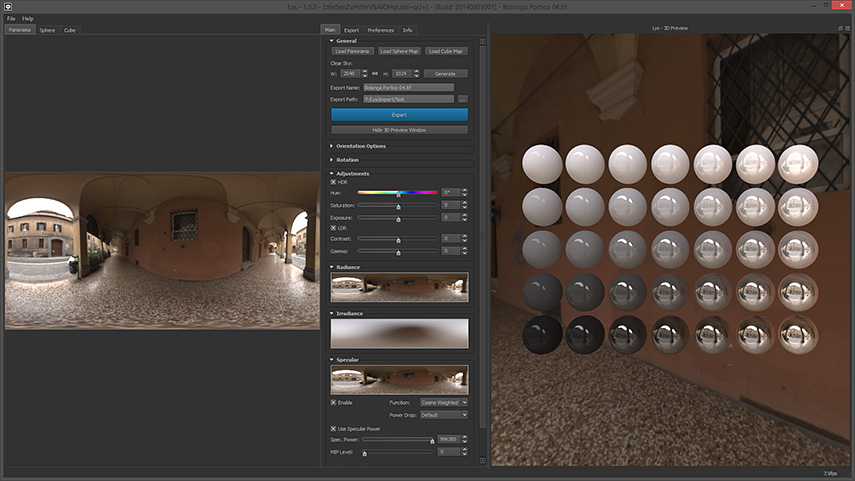
Real-time axis rotation and Cube map face position debugging
Lys gives you the flexibility to rotate in the XY and Z axes independently while retaining the integrity of the conversion between all layouts.
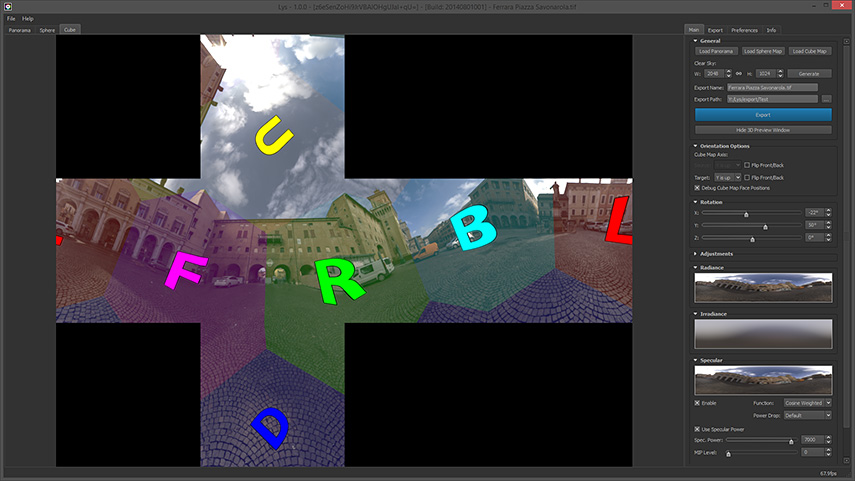
Cosine weighted, GGX and Gaussian specular terms
Our best in class Specular convolution has full support for Cosine weighted, GGX and Gaussian specular terms so you can be sure that everything conforms to current physically based industry standards, allowing you to integrate it into your workflow seamlessly with the full confidence that you are getting the absolute best quality possible for your projects needs.
Never before has specular convolution been so fast or easy to use!
BRDF convolved MIP maps with user configurable varying specular power/roughness
Lys has fully automated BRDF convolved MIP maps with user configurable varying Specular Power or Roughness to achieve HDR image based lighting in real-time graphics.
Upon generation of the specular texture Lys automatically calculates the correct specular/roughness level for each MIP individually, based on a choice of power drops, without any ugly seams as you go down the MIP chain.
Physically based Roughness & Specular power
Roughness and Specular Power are both fully supported and instantly cross convertible within Lys at the push of a button. Simply select your preferred standard and you are good to go!
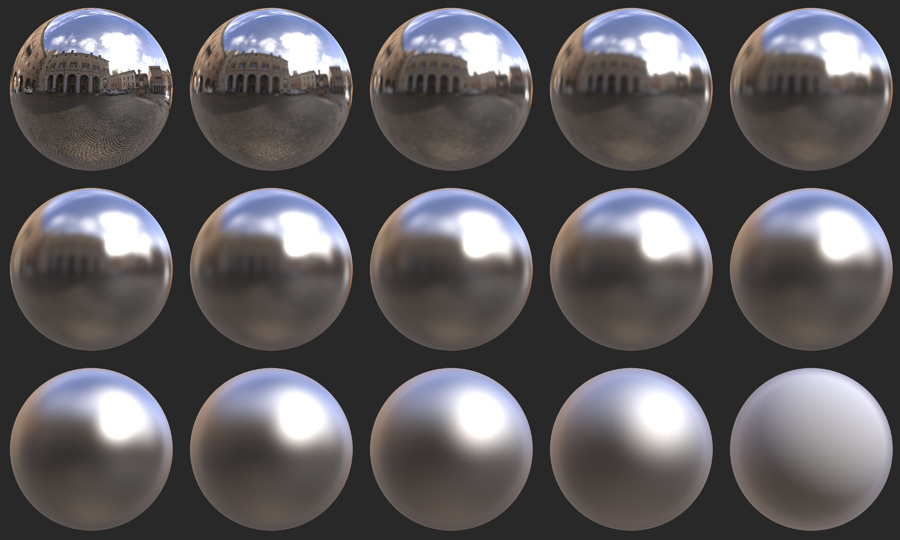
Instant Irradiance generation with spherical harmonic coefficients export
In tandem with the ultra-fast specular convolution Lys instantly generates Irradiance for you chosen image and even supports export for spherical harmonic coefficients triplets in text based or floating point .tiff flavours.
Spherical harmonic coefficients present an extremely low cost method of generating noiseless, high quality Irradiance by effectively reducing the footprint to a single 9×1 floating point texture map and helping you to keep memory free for other content, while simultaneously helping to ensure that the quality demands of current generation content are met.
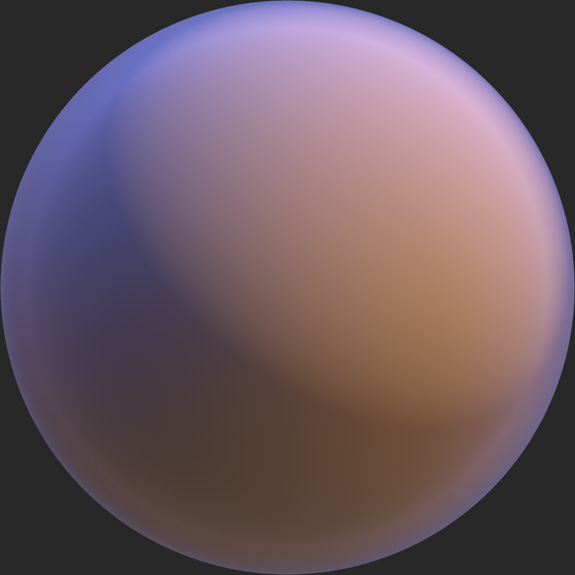
Physically based procedural sky generation
With full real-time control over camera altitude, Azimuth angle, Zenith angle and luminance within Clear Sky you can generate realistic vistas with a very small amount of time and effort.
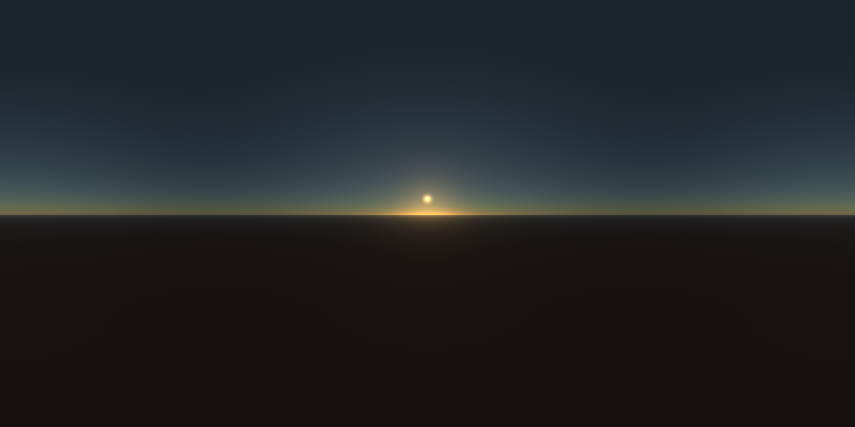
Direct3D 11 texture block compression on DirectX 11+ GPUs
Lys is ready to export your content at the highest possible quality for the lowest possible memory footprint with full support for BC6H and BC7 Direct3D 11 texture block compression on DirectX 11+ GPUs.
Being the first ever compressed format to fully support high dynamic range source data on the GPU, BC6H is now the format to use for HDR content within in the current generation of content.
Especially useful for HDR probes, BC6H handles gradients extremely well and has an outstanding compression ratio of 8-1 (12.5%).
BC7 is the first ever compressed format to accurately represent 8 bit (per channel) images with very marginal loss. Both gradients and discontinuities are handled excellently and when coupled with a compression ratio of 4-1 (25%) BC7 is the perfect solution for authoring high quality art.
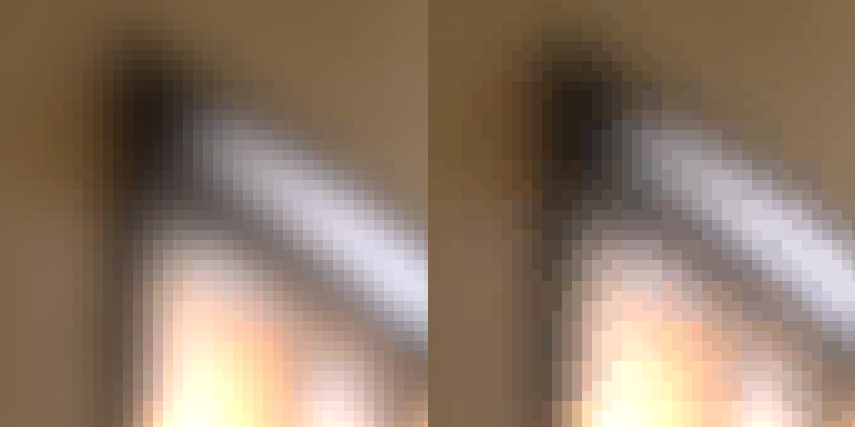
BC6H vs DXT1
User configurable Export
With unprecedented user control over export in Lys its possible to automatically calculate and populate the optimum export resolution of Radiance, Irradiance and Specular based of the size of the imported image, or if you so choose, you can individually configure the dimensions yourself for all layout types including per face size for cube maps!
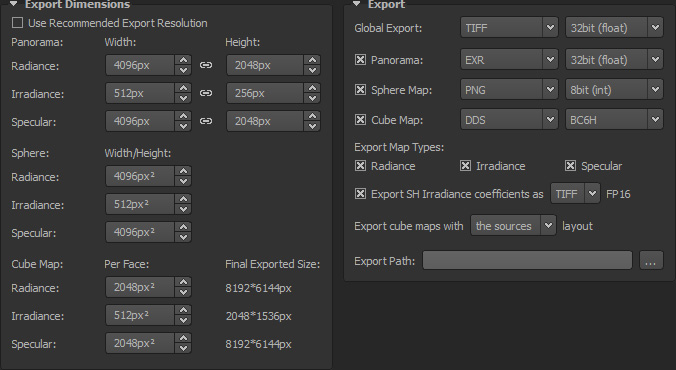
Best in class high precision work flow
All calculations & processing are performed in single precision floating point (float32).
Pixel perfect 8, 16 and 32bit support
Our robust 8, 16 and 32bit file I/O and image processing pipeline preserves your high precision data.
All calculations & processing within Lys are performed in single precision floating point (float32). We have painstakingly ensured that with our robust I/O pipeline, with full 8, 16 and 32bit (integer and float) support, you will never suffer from precision drop due to lazy or poor coding and can focus on creating great art!
You can be sure that your data is in good hands with Lys!
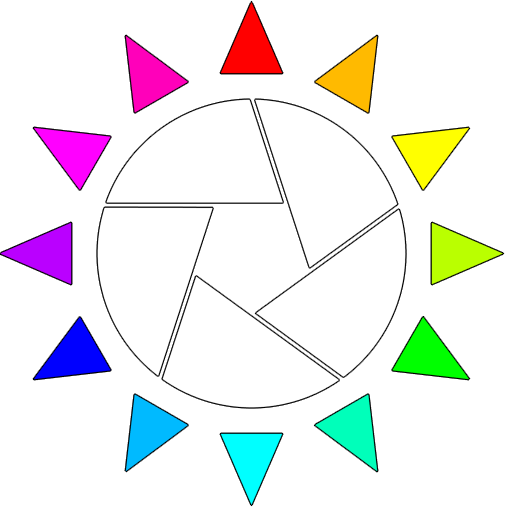
All HDRI photo based source images shown in the above were kindly provided by Marmoset.

Feedback and Support
We strive to make Lys the best that it can be, so please feel free to keep offering us your suggestions & giving us your valuable feedback on things such as bug reports and anything else that you feel could be improved within Lys.
You can also email us at support@knaldtech.com with any questions that you may have.
Artwork
We love seeing art that has Lys has helped create so please feel free to post your work in this thread so we can view it in all of its glory.
Social Media
Knald Technologies is now on Facebook, Twitter & Google+! Like us on Facebook Here, add us on Twitter Here & +1 us on Google+ Here.
Replies
https://youtu.be/I3AFVd_OreQ
Windows 8
GTX 780M
Let me know if you need any further information.
Hi,
I'm having trouble reproducing that issue here. It would be really helpful if you could answer a couple of questions.
Is it only Irradiance that wont save to that directory (do radiance and spec save ok)?
Is it possible to save to another location, such as your documents folder or something other than the root?
Are all your permissions set correctly for saving to
Which driver are you running currently?
Can you try running Lys as administrator and see if that changes anything please?
Please let me know how you get on.
Cheers
Same thing goes if I activate to export both radiance and specular in the export tab, but do not check the specular checkbox under the main tab. This only exports radiance without giving any reason as to why specular was not exported.
It would be nice if it tells me when and why it doesn't export a thing. Also, sometimes the export button is gray, would be really nice if the button had a tooltip that tells me what I need to do to enable the button.
Thanks for the info and comments!
We have been able to reproduce the checkbox/export bug and will have an update out for it soon.
Cheers!
Any plans to add a command-line mode? It'd be great to be able to batch process maps.
For example I'm rendering architectural cubemap viewpoints using 3ds Max and V-Ray, which outputs in vertical cross layout, but a client needs them as individual faces instead. AMD's cubemapgen has a batch mode, but it adds seams to the faces (even when there's no filtering!).
I will stick it on the list for possible features for the future
You should be able to copy the key directly from your web browser or the purchase email notification and paste directly into Lys.
https://www.knaldtech.com/licenses/ then View & manage Keys. Just highlight the key and copy/paste. It might copy whitespace so it's a good idea to paste it to notepad to remove that before then pasting into Lys.
Hope that helps
The little license window that pops up before the program first runs, that one didn't seem to allow pasting. So I typed it in by hand. I did get the key automatically by email, which was nice.
No worries, mate!
Currently we don't have a way to do this, but I would be happy to put this on our user wish list for you.
Cheers!
Added to the list
Since the 1.0 release of Lys we have been hard at work fixing a bug & adding new improvements to Lys.
In addition to bug fixes & optimizations in Lys 1.0.1 we have added the option to use Burley as a power drop, .HDR support, Copy/Paste, the ability to save your setting to a file & more!
What’s changed since Lys 1.0.0?
New Features, Improvements and Optimizations
Bug fixes
You can grab the new builds from your account
You can find build notes here: https://www.knaldtech.com/lys-update-build20160313001/
We really want to thank everyone for all the hard work and feedback during Lys's development. Please do continue sending us suggestions & posting everything you can!
Thanks for the comments. May I ask why you need this as an export option please?
Also, which export file type are you looking for? If it's DDS which format do you need?
Cheers!
I will add this to the user wish list but as this is considered a legacy method (new engines all support proper cube maps) we might not be able to get to it immediately, though we will try our best of course.
Since the 1.0.1 release of Lys we have been hard at work fixing a few bugs within Lys and adding a few miscellaneous under the hood improvements. Time for Lys 1.0.2!
What’s changed since Lys 1.0.1?
New Features, Improvements and Optimizations
Bug fixes
You can grab the new builds from your account
You can find build notes here: https://www.knaldtech.com/lys-update-build20160403001/
We really want to thank everyone for all the hard work and feedback during Lys's development. Please do continue sending us suggestions & posting everything you can!
Since the 1.0.2 release of Lys we have been hard at work fixing a few bugs within Lys and adding a few miscellaneous under the hood improvements. Time for Lys 1.0.3!
What’s changed since Lys 1.0.2?
New Features, Improvements and Optimizations
Bug fixes
You can grab the new builds from your account
You can find build notes here: https://www.knaldtech.com/lys-update-build20160814001/
We really want to thank everyone for all the hard work and feedback during Lys's development. Please do continue sending us suggestions & posting everything you can!
I'm wondering if Lys can reduce saturation by mip level? I'd like the highest mip to be original color, but fading to monochrome by the lowest mip. I'd like the glossy IBL reflections to have color, but irradiance IBL to be monochrome.
Reason is we would like to be able to judge color accuracy once models get into PBR/glTF. We are creating custom IBLs for use in glTF viewers like BabylonJS or the Khronos glTF Reference Viewer. https://sandbox.babylonjs.com/ http://gltf.ux3d.io/
We'd like monochrome irradiance so rougher surfaces get less color cast from the IBL. But I'm wondering if we were to keep color in the higher mips, would that still look OK? For example in a room with a wood floor, we don't want the warm color to influence a white couch so much.
Some screenshot examples here
https://github.com/KhronosGroup/glTF-WebGL-PBR/issues/127
Thanks for the info!
Will talk to you privately to get some more specifics and see if it's possible to add